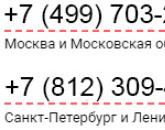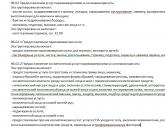Okvad: hairdressing services. What is the OKVED code for hairdressing services for SP OKVED for a beauty salon
The niche of hairdressing services looks attractive for a novice individual entrepreneur, but at the initial stage, questions often arise - how hairdressing services for individual entrepreneurs are indicated in OKVED, how to conclude an agreement with a hairdresser, etc. The issue of taxation is also important: if, for example, in rural areas to cut people can simply be at home, without legal registration, then in the city supervisory services vigilantly monitor entrepreneurs.
What OKVED codes are suitable for a beauty salon or a hairdresser?
The market of beauty salons, studios and hairdressing services looks attractive for starting a business, because there will always be people to get a haircut, do manicure, perm, etc., and such an enterprise is most likely in demand by the consumer. But, like any business, it requires proper registration, in particular, the choice of VD (type of activity) in the OKVED code directory.
The abbreviation hides the All-Russian Classifier of Types of Economic Activity. It spells out all types of economic activity that entrepreneurs are allowed to engage in on the territory of the Russian Federation.
When registering as an individual entrepreneur, a businessman must choose the code of the area in which he is going to work. You can specify several options, but one will appear in the papers as the main one. If it is planned to provide hairdressing services, the corresponding classifier code is entered into the application.
According to the classifier, code 96.02 is suitable: it encrypts the provision of services by beauty studios, salons, and hairdressers.
These include:
- hair washing, cutting, coloring, trimming, styling, highlighting, curling, etc .;
- shaving, trimming mustaches and beards;
- facial surface massage, manicure services, make-up.
Important: the manufacture of wigs is not included in this group.
Code 96.02 is divided into two subcategories.
96.02.01. This combination encodes hairdressing services to the population (PU):
- PU to all categories of people;
- hair washing, coloring, hair perm, haircut, wig repair (but not production), stylist services, etc.
Code 96.02.02. Cosmetic services are encrypted here:
- make-up, make-up of all types;
- the imposition of cosmetic masks;
- eyebrow, eyelash coloring, extension, perm procedures, shape correction;
- massage procedures on the neck, facial skin;
- complex measures for the care of the skin of the neck, face;
- manicure guidance;
- hand skin care
- pedicure;
- nail extension;
- cosmetics and hygiene of the client's feet;
- other popular services: SPA, etc.
Until July 11, 2017, the norms of OKVED version 029-2001 were applied to beauty salons, studios and hairdressing salons. But from the indicated date, another one is valid - ver. 029-2014.
If an individual entrepreneur plans to work without the involvement of hired employees, he, of course, should not enter into an agreement with himself. But if a person from the outside is involved in the position of a hairdresser, the businessman is obliged to formalize it properly by registering an employment relationship.
A typical employment contract includes:

- Full name of the entrepreneur and the employee being accepted, details of the individual entrepreneur;
- subject of the contract. This section indicates the position, place of work, mode (main employment or part-time), subordination, working conditions, etc.;
- period of validity and probationary period;
- terms of remuneration;
- working hours and rest, leave policy;
- duties of a hairdresser and his rights;
- a similar clause regarding the employer;
- terms of insurance, if applicable;
- the responsibility of each party;
- terms of termination of the contract;
- a series of final provisions relating to legal effect and dispute resolution;
- details of individual entrepreneur and employee.
Sample contract:
If necessary, section 6 can be supplemented with clause 6.3, according to which the duties and rights of an individual entrepreneur arise from labor legislation and other legal acts, agreements and paragraphs of the collective agreement.
This is a key issue for the entire organization of the IP business, because the entrepreneur will have to interact with the tax authorities in any case. At the same time, the inalienable right of every businessman is to use the form of taxation that is convenient for him personally, and it is important not to make a mistake in choosing.
Important: the choice is made immediately when applying for business registration! If the individual entrepreneur does not indicate the system immediately, within thirty days he will be transferred to the OSNO - the general procedure for paying taxes.
Simplified taxation system
 Since the staff of the barbershop is usually small, as well as the turnover, the STS looks like a suitable option.
Since the staff of the barbershop is usually small, as well as the turnover, the STS looks like a suitable option.
An individual entrepreneur will have to decide on what he will pay taxes:
- total income;
- taxation of profits "income minus expenses".
In the first case, the rate will be 6 percent, in the second - 15. If more than 60 percent of earnings are spent on expenses of a hairdresser, it is more convenient to use income tax. Otherwise, it will be more profitable to work at a 6 percent rate.
Tax payments are made once a quarter, and reports are submitted at the end of the year. And, of course, it is mandatory to equip the hairdresser with a cash register (and since 2017, the connection of cash desks to the OFD system has been gradually introduced to send fiscal documents to the state online repository).
UTII
This choice is quite widespread among hairdressers and beauty salons. A single tax on imputed income looks like the best option when the size of the salon is quite small, and there are only a few people on its staff, including the individual entrepreneur himself. With the growth of the enterprise, tax policy will probably have to be revised.
The calculation formula for UTII looks like the product of the number of employees, the base income (7500 rubles, for a given VD), the deflator coefficient, the base income adjustment indicator and the tax rate.
Working on UTII, the hairdresser also deducts funds to off-budget funds, while receiving the required tax benefits - but not more than half of the amount required to be paid.
Reporting is submitted quarterly, UTII allows you to work without a cash terminal and a current bank account.
This reduces the patent system of taxation. With it, an individual entrepreneur buys a tax patent for a certain period - from a month to a year.
Declaring its intention to work according to this scheme, the hairdresser observes:

- it is supposed to earn no more than a million rubles per year (for small cities. In large cities with a population of one million, the amount increases by 3-10 times);
- the number of employees will not exceed 15 (in the same premises or branch);
- An individual entrepreneur does not enter into relations of the type of joint property management, contractual partnership.
All tax payments consist of paying for a patent, the price of which is 6 percent of the estimated income. It does not require a long registration with a large package of documents, in addition, the PSN can be extended by notifying the Federal Tax Service by registered mail until December 20 of the current year.
Installing a cash register is not required, but it is required to record customer payments in a special income book. It is drawn up in a special form (given on the website of the Federal Tax Service, where it can be downloaded and printed).
In legal terminology, this method of recording revenue is called the "cash method".
Payment for a patent must be made before the expiration of its term, if such - up to six months. If it is valid for 6-12 months, the contributions can be divided: a third - no later than the 90th day from the start of the document, the rest - before the expiration of the patent term. An individual entrepreneur who forgot to transfer funds on time is forcibly transferred to the general system, and he will be allowed to return to UTII again only the next year.
As you can see, choosing which option to pay taxes on is not so difficult. You just need to calculate how it is more profitable to act, and do not forget to transfer contributions on time, and then a beauty salon or a hairdresser will bring a stable income and not cause anxiety.
96.02 Provision of services by hairdressers and beauty salons
96.04 Sports and recreation activities
96.09 Provision of other personal services n.e.c.
The codes correspond to the new edition of OKVED 2
FILES
Explanations and clarifications
The beauty business is one of the most popular types of entrepreneurial activity. These services are always in demand among the population, but their organization has several significant nuances.
If in other types of business planning should start with a concept, then when opening a beauty salon first paragraph there must be a question about the premises. The success of such a business directly depends on its location and material base, that is, on the correspondence of all this to the target audience. It is best to avoid subletting.
Second point a business project to open such a business is a matter for the masters. Their level will determine the client base, and hence future profits. The entrepreneur himself is also obliged to understand the main issues related to the work of masters of a particular profile.
Third determining factor- selection of consumables. What is important is their quality, compliance with customer expectations, benefits in the purchase, control during use.
Then you need to resolve administration issues: will the entrepreneur himself deal with this or is it necessary to look for a reliable manager.
And finally, before opening, you need to attend to problems that will become important with the start of work - ensuring cleanliness, washing, repair and maintenance of equipment.
As part of the operation of SPA salons, beauty salons and hairdressers, you can provide customers with such services:
- any manipulations with hair (cutting, washing, dyeing, styling, waving, straightening, building, trimming, etc.), including eyebrows, eyelashes and beards;
- cosmetic massage of the face, hands, feet, body with the application of various products;
- anti-cellulite wraps;
- manicure;
- pedicure, etc.;
If the corresponding additional OKVED is selected, you can sell perfume and cosmetic products in the premises of the beauty elephant.
When organizing a salon for the provision of cosmetology and hairdressing services, it must be remembered that since 2015 this type of activity has also included massage services, as well as applying makeup and tattoos.
Making wigs is not included in this type of business.
1) What OKVED should be applied when rendering cosmetology services and what type of taxation does it fall under? 2) We want to open a beauty salon (hairdresser, solarium, cosmetic services, manicure) What type of taxation should I choose? Better Sole Proprietorship or LLC?
You are advised
tax consultant
accounting and legal consultant
Good afternoon 1) In accordance with the All-Russian Classifier of Economic Activities, cosmetology services are classified under code 85.14 \"Other health protection activities\" without dividing cosmetology into therapeutic and surgical, as well as without dividing cosmetology services into medical and cosmetic. (Letter of the Ministry of Economic Development of the Russian Federation of July 12, 2007 N 10169-AB / D18). 2) IP, at the STS 15%, or UTII (depending on your location), if related products are sold in the salon, but only if the area of \u200b\u200bthe trading floor does not exceed 150 sq. m. If the area of the beauty salon is more than 150 square meters. m, then you can put a showcase next to the salon administrator, on the floor plan indicate the part of the room where the sale is carried out. In this case, an order is issued - to carry out the accompanying sale of goods here, in the marked zone. In the lease agreement, we recommend that you write that trade is carried out from the sales counter (the area of which is less than five square meters), and hairdressing services are provided on the rest of the rented area. In this case, you will be able to avoid claims from the tax authorities regarding the application of the UTII regime. Sincerely, Barinova Elena 2 opinion: The type of your activity can also be attributed to Section O. Provision of other communal, social and personal services. OKVED 93.02 Provision of services by hairdressers and beauty salons. If in the territory where services will be provided, UTII for household services has been introduced, then the use of UTII will be most beneficial for you (cosmetology services are household - OKUN code 081501). If you do not want to apply UTII, then you can choose USN or OSNO if you wish. What to choose: IP or LLC - depends on many factors. We note right away that conditionally all the existing differences between individual entrepreneurs and LLCs can be conditionally divided into several groups: Organizational. Economic. Legal consequences. Organizational differences - include all issues related to the registration and organization of a business in one form or another: Registration of an individual entrepreneur (IP) requires a minimum of documents, and does not require payment of authorized capital, obtaining a legal address. The amount of the state duty for registering an individual entrepreneur is 800 rubles, and for registering an LLC - 4000 rubles. Individual entrepreneurs do not need to open a current account and have a seal; for legal entities, the presence of a current account and a seal is mandatory. An individual entrepreneur can apply such types of taxation, such as a patent, that are not available to legal entities. The transition from LLC to sole proprietorship is much easier and faster. The reverse situation is much longer and more costly. The economic advantages of an LLC over an individual entrepreneur are more significant. Despite the fact that at first glance, an individual entrepreneur has lower initial costs, in the future it often turns out that the costs of maintaining a legal entity may turn out to be lower than that of an entrepreneur without forming a legal entity. For example, if an individual entrepreneur does not conduct business, then he still has the obligation to pay a fixed contribution to the Pension Fund, but for a limited liability company in such a situation, payments are not provided, it is enough just to provide "zero" reports and an information letter that payments were not made to individuals. Certain difficulties exist in the field of lending, where banks are traditionally more loyal to legal entities. For credit institutions, the main difference between IP and LLC is that the latter have a clear amount of authorized capital, which, if necessary, can be levied. And even if in most cases the authorized capital of an LLC is at least ten thousand, then the probability of obtaining a loan from an organization will be higher than that of an individual entrepreneur. At the same time, the legislation is more loyal to individual entrepreneurs, for example, the amount of penalties for administrative offenses for them is less than for legal entities. Sincerely, Larisa Alexandrovna
The sphere of beauty was relevant in society hundreds of years ago. Barbers and hairdressers, barbers and makeup artists of those times were valued in the high classes, and the best craftsmen were even invited to the royal court to serve the elite. Today, the activity of beauty salons is more mass and does not constitute a special cult. But this prevalence has become beneficial for the state. After all, each new beauty salon brings money to the state treasury in the form of taxes and deductions to various funds. Therefore, in OKVED 2016, hairdressing services for individual entrepreneurs and legal entities have a very specific structure and their own subclass.
To find codes for organizing a hairdressing business in the All-Russian Classifier of Economic Activities, you do not need to make much effort. Unlike many other profiles and directions, this is simplified to the limit. Target information by type is located in section “S” in subclass 96.02, which is the code for filling out an application when passing the state registration procedure for a new business entity. Using this grouping, you will deprive yourself of the need to enter clarifying data on the relevant pages of the application. However, if we are talking about a highly specialized business, and not about a general-purpose salon, additional information may also come in handy.
What is included in this activity
In OKVED 2016, hairdressing services are represented by a rather extensive list of specialized operations that can be found in any beauty salon. So, these include:
- Hair trimming.
- Women's and men's haircuts.
- Curling and straightening.
- Chemical operations to change the appearance of hair.
- Shaving beards, eyebrows, sideburns.
- Shaving and contouring.
- Laying and styling.
That is, when organizing your own business, you can indicate in the certificate of registration only specialized areas for a hairdresser. But today it is difficult to find organizations that deal exclusively with haircuts and hairstyles. Firstly, it is unprofitable against the backdrop of serious competition, and secondly, because of this approach, precious customers are lost, who need not only trim their bangs.
However, if with such a limited set of codes you decide to also provide make-up, manicure and pedicure, massage, SPA procedures, then the very first tax audit that reveals income from these types of activities will impose serious penalties on you. And if there is also specialized equipment, you can lose it.
Additional destinations
If you carefully study OKVED, hairdressing services are not so unambiguous and limited. This includes other areas of activity. For example, it can be working with wigs, combing them, adjusting, styling, fixing hairpieces. The only exception is the production of wigs. In addition, the following areas can be distinguished in separate areas:
- Manicure and skin care.
- Pedicure and foot care.
- SPA procedures aimed at healing and improving the visual qualities of the skin.
- Massage of the face, neck and other parts of the body.
- Peeling, scrubbing, mechanical effect on the epidermis.
- Make-up services, including the creation of images through professional make-up, etc.
In addition, we forgot to mention all kinds of dyeing, highlighting, coloring, bleaching and other procedures associated with color and structural changes in hair.
Practical Observations
If your task is to open a narrow-profile salon that will provide a limited set of services in only one direction, you can indicate all the subclasses that interest you on the relevant pages of the application during state registration with the Federal Tax Service. But it's much easier to use the whole grouping. It will not oblige you to perform the range of work in which you do not specialize, but will become insurance in case of an unplanned expansion of areas of activity within the walls of the organization.
And now let's say a few words about the organizational part. The procedure for opening a new business entity in the form of a legal or natural person is almost the same. But it is worth remembering some significant differences that may further affect the course of events. Form No. P21001 is adopted as the main application form for an individual entrepreneur, while future organizations use form No. P11001. These forms differ in form and content. An individual indicates codes from the All-Russian classifier of types of economic activity on sheet "A", and legal entities are required to enter these data in the corresponding fields of sheet "I".

In addition, if you are a legal entity, then for legal work on the territory of the Russian Federation, all codes for the types of professional activity must be included in the company's charter, which contains the main provisions on the form of management and organization of activities. So be careful when drawing up and filling out documents in order to register the first time and start working in the field of hairdressing services without hindrance.
Popular
- Step by step massage parlor business plan with opening
- Trade in vegetables, fruits and berries as a profitable business
- How to open a travel agency from scratch
- How to open a travel agency from scratch without experience and money IP in tourism pros and cons
- Sale and production of souvenirs of the system of taxation and OKVED
- What is the OKVED code for hairdressing services for SP OKVED for a beauty salon
- Capital investment efficiency ratio
- Small business in Russia: facts and figures
- How to start trading on the stock exchange - detailed instructions
- Exchange spread - what is it?




